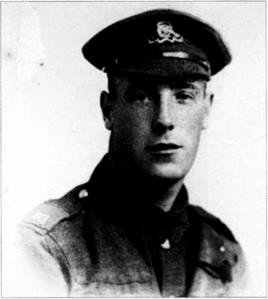The Rittmeister’s Forced Landing
At least nine soldiers witnessed the forced landing of the Triplane from nearby, and many others from afar. Depending upon how familiar the distant witness was with the aircraft and with slant views, is how he interpreted what he saw. Some later stated that with a dead pilot in the cockpit, the Triplane made a perfect landing and rolled to a stop undamaged. The latter fiction seems to be preferred by film directors.
It is worthy of recognition that every one of the descriptions provided by the nine soldiers appears to depict a totally different event from the one described by Squadron Leader, (later Air Vice – Marshal) Francis Mellersh at an RAF Staff College lecture in 1931.To quote him:
Suddenly the Triplane did two extremely rapid ‘flick’ rolls and crashed straight into the ground with full engine on… I flew right over it after it had crashed, however, and saw that it was a complete wreck.
The nine with the close view were:
Lieutenant Turner and Gunner Ernest Twycross, Artillery Officer and Signaller respectively, who were in the Royal Garrison Artillery FOP at Sainte Colette.
Two army signallers. Privates Len Dalton and Harvey, who were mending a telephone cable near what the local farmers call a sugar beet pie. That is a pile of sugar beets partially buried in a pit. The earth removed is then placed on top like a piecrust. In that environment, the sugar beets both soften and sweeten at the same time. The pie was actually in the field where the machine came down. Both men later stated that the Triplane: ‘… landed in front of us.’ They did not say crashed.
Two army signallers. Privates Vernon Elix and Jock Newell, who had just finished burying a telephone cable across the Corbie to Bray road.
Gunner George Ridgway, and Privates Emery and Jeffrey who had also seen most of the air and ground actions.
Again making a montage of what these various witnesses say they saw, it is most probable that the following occurred.
With von Richthofen having switched the engines single magneto OFF. the forward motion of the Triplane was now driving the propeller against the compression of the engine. This absorbed a lot of energy and acted as a dive brake thus providing a steep descent without an increase in speed. An unintentional tribute to von Richthofens airmanship was given by a soldier who was of the opinion that the Triplane was obviously out of control since it came down sideways. Again, the witness, not being an aeroplane pilot, did not realise the import of what he saw; viz von Richthofen was alive. He had put his Triplane into a side slip so as not to overshoot the field. This steepened the angle even more. From a distant front or rear view in which no forward motion would be seen, the Triplane would appear to be descending almost vertically which matches Browns description.
The trees on the west side of the field now hid the Triplane from all the machine gunners except Private Emery who, without having fired a single shot, watched his almostoth-victory arrive at his feet as if by special request. Except for Lieutenant Woods platoon, the soldiers who were in that general area were carrying drums of wire, pliers, screwdrivers and field telephones at the time. Privates Elix and Newell thought that the Triplane was planning to strafe them so they downed tools and dived for cover. It is doubtful, therefore, whether anyone fired at the Triplane in the last part of its descent even though the late Ed Ferko suggested it as a possibility.
Doctor Jose Segura MD. pointed out to the authors that regardless of which geographical position the Triplane had been in, the pilots reaction to the wound would not have differed. At landing speed the muscular contraction would have caused a spectacular nose-up stall followed – in most cases — by a horrendous crash and fire.
Private Ridgway, from his 20-foot high perch on the chimney side, saw the end of the show as well. At about tree-top height, von Richthofen ceased side-slipping and placed the Triplane in landing attitude. One of two things happened next. Either due to weakness he lost the strength to hold the ‘joy stick’ back (on an aeroplane without a trim wheel the force required can be considerable) or, with or without fast fading faculties he misjudged his height. The landing wheels hit hard. The impetus pushed the tail down
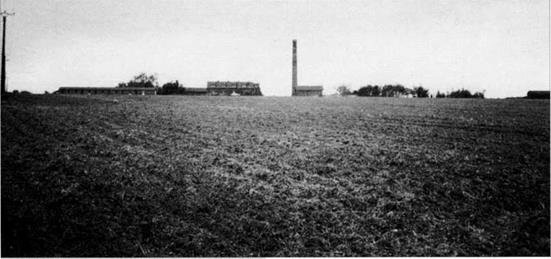
Above: The Sainte Colette brickworks, facing north. The Triplane came down in this field.
Right: Gunner Ernest Twycross – the first soldier to reach the crashed Triplane. He saw von Richthofen die.
and the Triplane, which still had just enough speed to fly, took off again in a nose-high attitude. It climbed to about 12 feet above the ground losing speed as it went. Von Richthofen took no corrective action and a classic novice pilot landing stall, followed by a dropped wing took place. At the time of the stall, the driving force of the air pressure on the propeller became less than the resistive force of the engine compression; the engine and propeller ceased to rotate. The Triplane was not high enough off the ground for the nose to drop very far. The undercarriage and the lower left wing took the worst shock. The wheels splayed outwards as the rubber shock-absorbers parted inside the fairing, which looked like a small fourth wing between the wheels, and the legs were pushed backwards. One leg is said to have separated from the fuselage. The soldered seams of the petrol tank and the oil tank parted and the liquids began to escape. If the petrol tank had still been pressurised at this time, the fuel would have sprayed out and most likely caught fire, hence opening the tank vent valve at the right time was an important part of emergency landing drill. With unbalanced resistance to forward motion as it slid along the ground, the Triplane made a ground loop to the left of about one and half turns.
The Fokker finally became stationary with its
|
|
nose pointing towards the town of Bonnay (west), and resting, with its tail canted upwards, two or three feet away from the‘sugar beet pie. We know this because Private Emery later recalled being able to walk between the ‘pie’ and the front of the machine, so the Triplane had not actually ended up with its nose into it.
During the short glide the engine had cooled somewhat which was fortunate as petrol was still leaking from the tank. One blade of the propeller was broken off. The machine was quite easily repairable; airframe mechanics at flying training schools dealt with worse mishaps every week.
The names of those who claim to have been amongst the first to reach the downed Triplane form an impressive list! A point of interest is that of the myriad of claimants, none could recall who was actually the first. A half-clue came from one who said that it was some chap he did not recognise and that he must have been from some other unit stationed in the area.
In 1996, quite by chance, the mystery man was revealed to the authors, as having been Gunner Ernest Twycross of the Royal Garrison Artillery (RGA). His testimony strongly supports that of Privates Dalton and Harvey; namely that the Triplane did not slam into the ground and smash itself to pieces but made a reasonable landing. It also, once and for all time, definitely settles the dispute as exactly when Manfred von Richthofen died.
The RGA had two mobile 18-pounder guns on the Corbie to Bray road which were firing on targets of opportunity. Lieutenant Turner, who was in command of them, was ‘spotting*, from his Sainte Colette observation trench about 150 yards from the sugar beet pie. His assistant was Gunner Twycross, a signals specialist. No sooner had the Triplane stopped than Turner instructed Twycross to climb out and take the German pilot prisoner before he could set his aeroplane on fire.
As the gunner reached the cockpit, the pilot, who was covered with blood, gurgled or gasped three words and then died. The first two sounded like: "War es..’ . The third one was definitely ‘Kaput*. It can be safely assumed that he said:‘AUes Kaput* meaning‘It’s all over for me, I’m finished.’ Gunner Twycross, smelling the petrol, hearing the ticking sounds made by hot metal as it cools down, and seeing several soldiers running towards the aeroplane, prudently returned to his post.
Ernest Twycross’s son had taken his father on a nostalgic visit to the old battlefields of France in June 1970 (he was suffering with cancer and was to die in 1973), and upon reaching the Corbie – Bray road the old soldier asked his son to stop and he looked out across the field in front of the brickworks:
I did not know why he wanted to visit this area, and. after stopping the car he said they had had a forward OP near here (pointing to the fields next to the road) and: *we used to tether our mules along this road with chains’ he said. He then told me that he and his officer witnessed a fight between three aircraft, two RAF and one German
Triplane. My father said the Triplane appeared to be in trouble and he and his officer watched it force land under control by the side of the road. As the aircraft appeared to have landed intact my father was sent to capture the pilot and aircraft before the pilot destroyed it. My father had no idea who the pilot was. He arrived at the aircraft which in my father’s own words, had come to rest against a pile of ’mangel wurzles’. The pilot was still alive and my father’s intent was to capture him and to get him out of the cockpit because of the smell of petrol and the engine was ticking as it cooled down. The pilot gurgled or gasped: ’… kaput,’ and died. He said the words sounded like ’War es kaput,’ but with the noise around he couldn’t be sure, but ‘kaput’ came into it. A few moments later Australian troops and an officer arrived and my father left the site. It was only afterwards that he learnt that the pilot was von Richthofen, a famous German aviator.
As to how steep the Triplane’s descent really was, once again slant views can be deceptive. The observer for the German 18th Feld Artillerie Regiment, Leutnant Schonemann, (in the church tower in Le Hamel) reported that it was so steep that the pilot could not possibly have survived the crash. On the other hand, Leutnant Fabian, 16th Artillerie, viewing from a different angle, reported a good landing but added that the pilot had remained in the cockpit. Infantry Leutnant Koster, from yet another viewing angle, reported that a red Triplane had glided down to a landing. Other German artillery men, looking through rangefinders, saw Allied soldiers running towards the downed Triplane. Unfortunately some German soldiers and airmen remembered a newspaper propaganda story from the previous year which stated that the British had offered riches, his own personal, private aeroplane and a medal to the airman who could kill the German national hero who, so it was written, was terrifying their airmen. The reported glide to a good landing and the running soldiers provided a useful basis for an anti-British propaganda story that von Richthofen stepped down from the cockpit with his hands up and was murdered for bounty by the first men to reach the Triplane. The story, which has several versions, has been re-cycled every two or three decades as ‘new evidence’. It is just about due to be ‘discovered’ again!
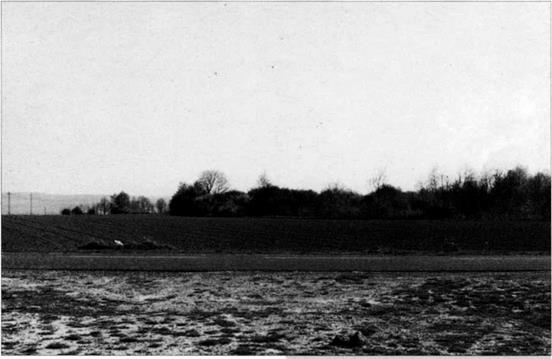
Sergeant E C Tibbetts, of the 53rd Battery, who had been walking along the Corbie – Mericourt road while watching the final stages of the chase, thought the Triplane had made a remarkable landing and wondered whether the pilot had just lived long enough to bring it down in the field in front of the brickworks.
Possibly the second soldier to reach the Triplane was Signals Sergeant Norman Symes, an Australian. In December 1982 he told the Sydney Sunday Press:
l looked straight into the dead pilot’s face. A fine looking fellow he was, despite the wound on his forehead. Beside the dead man in the cockpit lay a loosely handled parachute. I gathered it up and ran it to HQ. I am claiming no credit; I didn’t shoot at him. I didn’t even have my pistol with me.
Sergeant Symes neither saw nor heard of the parachute again and wondered what had happened to it. Many denied, and some still deny, that it ever existed which makes the Heinecke parachute harness that von Richthofen was wearing somewhat inexplicable! From other sources it is understood that some of the girls in Corbie and Amiens might have been able to help Sergeant Symes with his enquiries.
While the parachute was used by balloon observers of both sides. Allied airmen were not
Above: The field where von Richthofen came down today, facing south with the brickworks behind. The trees and shrubs cover the area that in 1918 was a quarry.
Opposite: Aerial view of the brickworks and the field into which the Triplane crash landed. From the nearby trenches Gunner Twycross went to the red machine, just yards away from his OP. Close to the north side of the road is the drainage ditch into which the Triplane was pulled out of sight of the Germans.
allowed such luxury. However, German airmen had just started to use them and a number would save their lives in the coming months – provided they worked, which wasn’t always guaranteed; however, there is no record of any airman returning his parachute with a complaint.
The pilot of the Triplane was identified as the German top-scoring ace, Rittmeister Manfred Freiherr von Richthofen. Souveniring of the Fokker began immediately the word spread around who the pilot was. Some lucky soldiers with pocket knives acquired sections of wing fabric with the German insignia; Private Wormald was one of them having run over from the Buie/Evans machine-gun location. It was a little risky to go near the Triplane as an occasional short shot from German artillery to the south was arriving nearby. One soldier hearing a ‘crump’ and
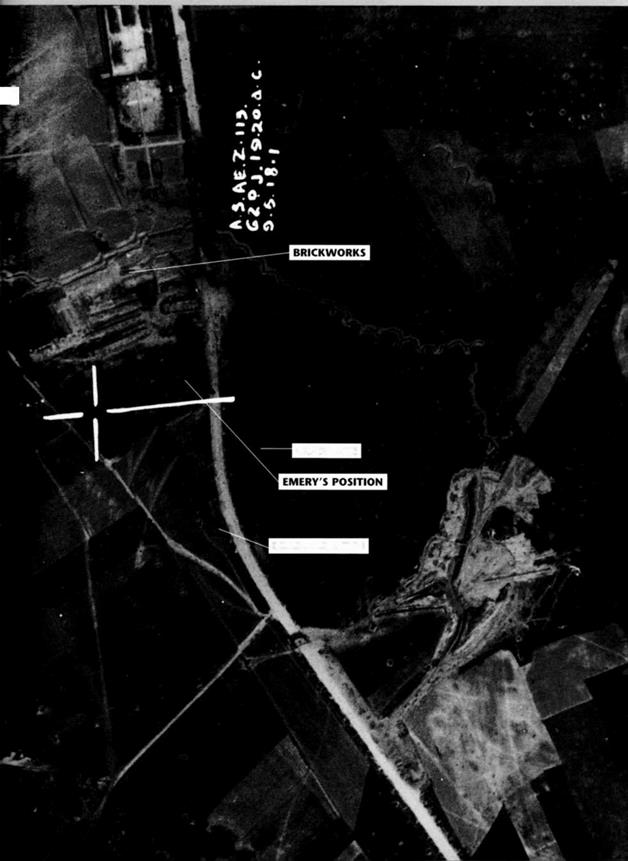 CRASH SITE
CRASH SITE
DRAINAGE DITCH
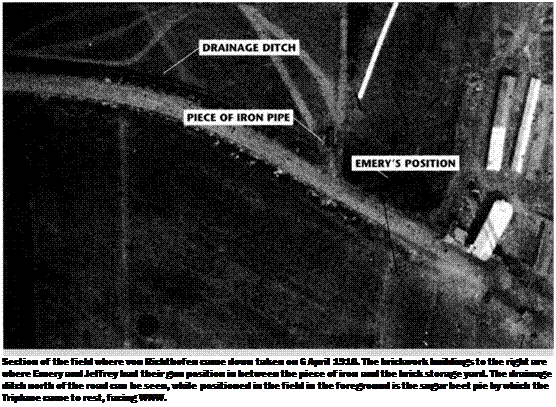
feeling something strike him thought that he had been wounded. His colleagues did not feel that being hit by a flying piece of sugar beet merited much compassion or sympathy. An officer. Captain E C Adams of the 44th Battalion A IF, came along and shooed the crowd away; mainly for the soldiers’ own safety. Guard was mounted over the Triplane to prevent further looting but unfortunately its members were chosen from volunteers for the task!
In this area, 3 Squadron AFC’, to which all Allied or German crashed or force-landed aircraft ‘belonged’ by official writ, was asked to come and collect its property. Enemy aircraft brought down inside Allied lines were never retained by the army however they were acquired. They were handed over to the RAF and most would be given an RAF ‘G’ number.
At 1400 hours, approximately, the 3 Squadron aircraft recovery team, commanded by Lieutenant W I Warneford and supervised by Air Mechanic 1 st Class (later Warrant Officer) Alfred Alexander Boxall-Chapman appeared. The Lieutenant, who appears to have been detained at Battalion HQ during the progress of the work, was, in some inexplicable manner, assumed by some
unidentified officer to have been Lieutenant Mellersh of 209 Squadron. Amongst the troops, rumour seems to have identified him as the pilot of the Camel who had come to thank Gunners Buie and Evans for having saved his life. The next day, the visitor’s name to some, was Lieutenant May; to others he was Captain Brown. These errors found their way into official reports, and personal letters, and much confusion this created, (see Appendices C and IX)
A photograph of the Triplane taken the next day has sometimes been used to depict the ‘wreck’. It was taken after the aeroplane had been ‘ratted’ by souvenir hunters and then partially reassembled specially for the pictures.
The Headquarters of the British Fourth Army were duly informed that the ‘Red Devil’ himself had been shot down and killed.
Indirectly, the broken firing pin in the right-hand gun was to have unfortunate consequences upon the beliefs of those who looked at von Richthofen’s body that afternoon and evening. Because of the firing pin defect, von Richthofen had loosened his safety harness so as to be able to reach forward to re-cock the machine gun each
These two sketches illustrate the problem created by plotting April 1918 map references on a August 1917 map. The result is that the Triplane is shown to have come to rest north of the road instead of in the field to the south of the road.
time it stopped. Upon the final impact with the ground, his unrestrained body was thrown forwards allowing his face to impact the gun-butts which projected back into the cockpit. There was a lot of blood around, which appeared to have flowed from the mouth. Private Emery said that von Richthofen looked like a stuck bullock; the blood reached down to his fur overboots and had actually soaked into the top of one.
Injuries were observed to his mouth, to his neck, behind his right eye (some say left), to his legs, to his abdomen, to the front of his chest near his left shoulder and inside his right armpit. Depending upon the haste and/or the expertise of the spectators, all of those injuries or merely the last two, were taken to be gunshot wounds. When one takes into consideration the hundreds of shots which were fired at the Baron during the last two minutes of his life, that was not unreasonable.
The actual location on the ground where the Triplane came to rest has been the subject of much unnecessary dispute. The co-ordinates were estimated by all concerned based on their April 1918 issue Field Map 621). The nearby roads do not run due north-south or due east-west which influences even the most careful judgement. Under the circumstances, they did quite well. Absolute accuracy was not required for their purpose; surveying instruments would have been needed to do better.
The dispute arose due to the point reference grid on the 1916 and 1917 maps of Military Zone 621) having been over-printed slightly out of position. The error was corrected on the 1918 edition by shifting the horizontal lines about 100 yards to the south. If the location given by Lieutenant Travers – 62D. J.19.b. – is plotted on a 1916 or 1917 map, the pinpoint will be found to be NORTH of the Corbie to Bray road. Fortunately, aerial photographs show some type of sheds on the north side which proves those who gave the reference used the April 1918 edition. The allegation that the place where the Triplane came to rest is uncertain, is another case of a controversy having been created out of thin air. The spot was definitely SOUTH of the road and the exact position is known to within 50 yards.
According to the Barons mother, Kunigunde Freifrau von Richthofen, the Kaiser had taken a firm decision to order the Rittmeister to fly no more after achieving his 80th victory. Previous efforts by ‘higher authority’, to use the Rittmeister’s own words, had been circumvented or simply ‘forgotten’.This time it was final. In her book, My War Diary, the Baroness describes how on the morning of Sunday 21 April 1918 the news reached the Kaiser that Manfred had scored his 79th and 80th victories the previous day, thus doubling the score of his former mentor and stafFelflihrer, Oswald Boelcke. Before he could issue the edict on Monday the 22nd, news arrived that the Rittmeister was missing. The door of fate turns on very small hinges.











